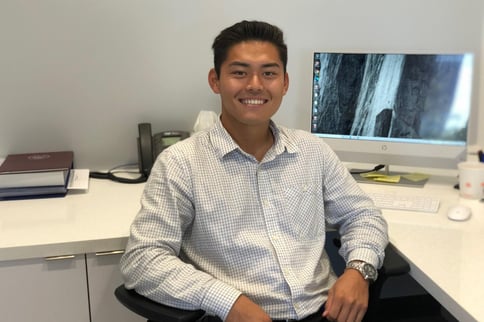At some point during a job search, you might not have any relevant work experience in your background that aligns with prospective jobs. This means you could be in an interview with the obstacle of marketing yourself. The great thing to know is that you are not in this position alone. Many individuals do not have direct work experience in any line of work. Most work differs because the job expectations, environment, or experience slightly changes. According to a 2022 study from the New York Federal Reserve Bank, only 27% of people use their degrees (Wise, 2022). With that said, it is more important for people to understand how their traits can be applied and adapted to the potential job by approaching every job as a new learning experience.
Keeping this perspective in mind, a story can be told that portrays transferable skills relative to the job description, despite not having past relevant work experiences. This article is your roadmap on how to effectively tell your story in an interview, hence remaining marketable for the position.

Before coming to the interview you want to be prepared to amplify how you fit into the company and how you can help the company by being an employee. The best way to prepare is to use the following strategies:
Researching the company beforehand, especially the role, will show your diligence in pursuing the company and demonstrate your interest in the job. During the interview, this same research will also allow you to better align yourself with the company's mission and values. Understanding what the company is looking for can help in preparing your story and answers. Moreover, knowing the company or establishment will set a foundation for forming meaningful questions available to ask the interviewer at the end.
Additionally, researching the interviewer(s) is helpful because it gives you a better idea about what they are looking for, and you can make sure they know how you meet their needs for the job. Doing this research beforehand will also give you a boost of confidence in your responses to the interview questions.
⭐ Read: 5 Ways to Win Your Job Interview
Consider your background and research the typical starting salary for the role to which you are applying. Using both pieces of information, you want to weigh the factors together and provide the interviewer with your expected salary. Keep in mind, that even if you do not have relevant experience, you do not want to underestimate your value as a potential employee. If you believe, you have invaluable skills it is okay to negotiate a salary range that is reasonable and matches what you offer. Be open and honest. Some questions you might ask yourself when making this decision are what you bring, what the company will gain, and why you believe this salary fits your abilities.
First impressions matter. How you introduce yourself and the way you leave an interview can make all the difference. In both cases, context and engagement matter as they captivate your interviewer, hence making them interested in who you are.
For great introductions, use an elevator pitch. You want to spend 60 seconds or less to introduce interests, skills, goals, and personal qualities. Highlighting these traits can make the interviewer(s) more comfortable while demonstrating that you are enabled to meet or exceed the job and company requirements.
After starting your interview off strong, you should not lose this energy, so respond to the interview questions by sharing your experiences. These experiences should be illustrated in a story and corroborate your skills.

The prepared 1 to 2-minute stories are called your STAR stories. STAR responses refer to the method that is used when answering the interview question because of the way they are developed. STAR is an acronym that stands for situation, task, action, and result, with each part tailored and constructed, to be a fitting response. Breaking this method down, let’s understand how to answer each part of the STAR reference point.
The S in STAR stands for situation. This will be the entire set of “frame of reference” for your response. In telling a story about your situation, you are identifying a challenge(s) you faced or the problem that had to be resolved and why. The response should remain around 20 seconds and needs to be concise and informative.
After setting up your situation, you will proceed to answer: what you needed to do to solve the problem and what was your strategy. By explaining the task as an interviewee, you have demonstrated your process for approaching problems. The process you take is emphasized because even if you failed at overcoming the problem, it still demonstrates initiative. The goal is to show your process within 30 seconds.
After showcasing the strategically planned overcoming experiences, it should be understood that this only relays the intentions for solving the problem. Overall, as an interviewee, you should still walk them through the major action steps taken in solving the problem. To exhibit your performance you want to answer what you did chronologically to solve the problem or complete the task. It is also equally important to present what challenges you faced and how you overcame them. In each point, you additionally want to point out the answer to what skills you are demonstrating. By depicting your capabilities to complete a task and demonstrating vital skills for the work environment, you are displaying your character in 45 to 60 seconds. By validating your character, you are giving an idea to the establishment confirming why you are the best candidate for the job.
Lastly, you want to give the company the result of your actions. By explaining the outcome(s) in 20 seconds you are also giving the results of your efforts. It is important to understand that the results, do not always have to be a big overcoming accomplishment. Although it is nice and preferred to tell a story with a happy ending, the reality is that sometimes you may not have solved the problem. Sometimes failures happened and they were out of your control. The most important factor is that you maximized the success of your outcome, given the constraints of the situation. When your story is complete you always to want close with a summary.
Since STAR can be used for almost any interview question you want to clarify to the interviewer how your answer connects to the question. For that reason, connect what you learned from this experience back to the question in 5 to 10 seconds.
When using STAR one can prepare for these interviews by preparing for specific topics. Interviewers commonly ask questions with the following topics because they note your experiences that verify your skills in action. Topics you should integrate into your answer include:
⭐Learn: What's the STAR Method?
At the end of the interview, you want to quickly understand why particular questions were being asked and how this information helps them hire you. Understanding the intentions of the questions makes it easier to process what you need to highlight before leaving. It also allows you to clarify anything you said before, thus mitigating doubt with the hiring committee. That said, before the interview ends, think of yourself as a potential employer and be ready with the following:
Supporting your conclusions and leaving a thoughtful impression will help ensure that the interviewers and hiring managers consider you or are open to further discussion.
While preparing to answer the topics in a STAR format is necessary, along with your research efforts, and fantastic impressions, you also need key components. These components can be evaluated beforehand by implementing smart tips that can further set you up for a notable interview. These principles that you should ask yourself:
A response considering your interviewer will always provide the establishment with a more clear illustration of how you work. While your responses are being evaluated, consider that the company is also looking for you to showcase qualities essential to their success. The interviewer may also ask you direct questions. Be prepared, and ask yourself
Chances are that interviewers will be asking themselves these questions or questions similar when cross-examining you. Therefore, you want to be knowledgeable about these interview elements and use them as an advantage to help you prepare stories that already give them a clear answer. Knowing your reasoning for applying will allow you to further tailor your answers with a captivating energy that is practiced, practiced, practiced. It also is an opportunity to make an impression, since you will be giving a clear answer beforehand, which they will notice while choosing new hires.
Remember every interview will be different, but as a candidate, no matter your background experience, you can still show the company that you are an asset. Emphasizing your value, you may not be qualified with experience, but you might have plenty of valuable skills, hence making you a marketable prospect. 
After an interview, you always want to send a thank you email which can double as a follow-up to the interview process. This email needs to contain the following information:
By sending a thank you email you are showing your respects but also benefiting from such an email. That is because your investment of time in sending a thank you email increases your chances of standing out compared to other applicants. For insight, one study with Harvard Business has shown that only one out of four candidates will send a thank you message after their interview. From these statistics, about 80% of human resources managers said that the thank you email was helpful when reviewing the candidate (Littlefield, 2022).
⭐Read: How to Write a Thank You Email After an Interview
Like all interviews, keep in mind that scenarios can be different depending on the job description, line of work, or network. It is okay to send follow-up emails. If you align with the company vision, but not the particular role you applied for, the company might have other open positions where they can see you participating. It is okay to ask if any other positions are open. No matter the outcome, the important part is to always practice, practice, practice, as you might eventually end up where you want to be.
Wishing you the best of success in your interviews.
Download The Ultimate Guide to Wet Lab Incubators in Southern California, a handbook to assist life science start-ups through the entire decision-making process to find wet lab space.
Download Now